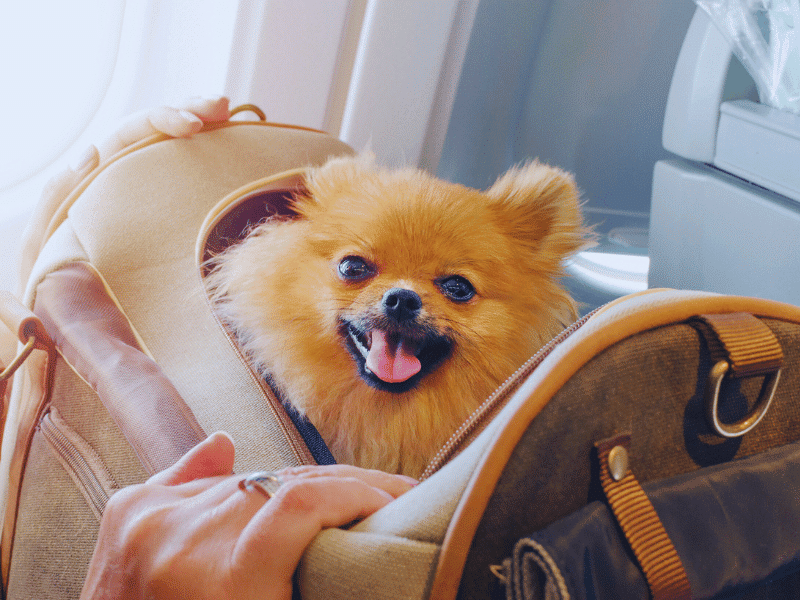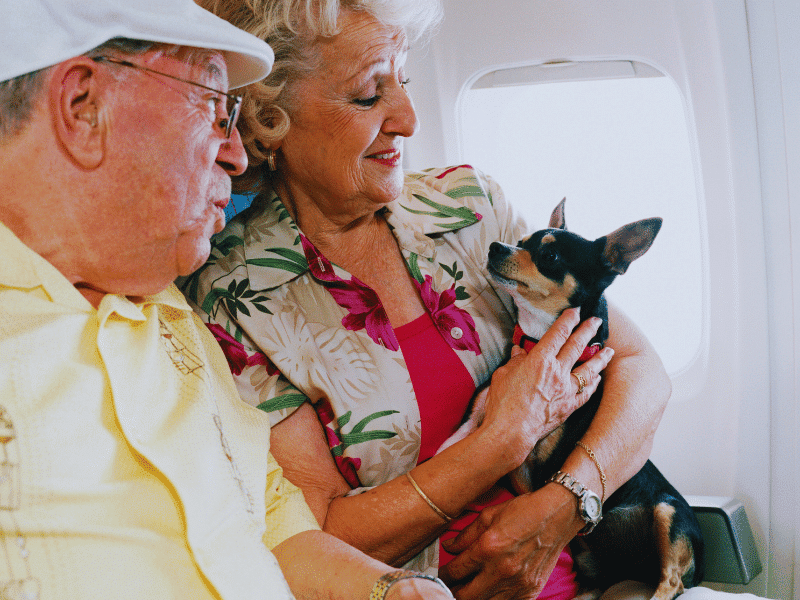The decision to travel across the country with Max, my golden retriever, was both exciting and nerve-wracking. As much as I wanted him by my side, the thought of navigating an airport and boarding a plane with him felt like a challenge. But Max, with his wagging tail and curious eyes, made it clear he was up for the adventure.
Preparing for the Trip
The preparation began weeks in advance. I researched airlines that allowed pets in the cabin and chose one with pet-friendly policies. Max had always been my companion, but this would be his first flight. A visit to the vet confirmed he was fit to travel, and I got his health certificate and vaccination records ready.
Next came the pet carrier. It had to meet airline regulations and be comfortable for Max. After a few practice sessions at home, he seemed to enjoy curling up inside it, especially when I tossed in his favorite chew toy.
At the Airport

The day of the flight arrived, and Max’s excitement was contagious. We reached the airport early to avoid the rush. The security process was smoother than I expected—Max walked through the metal detector while I carried the empty carrier. The sight of a dog strolling through the terminal brought smiles to many faces, and Max basked in the attention.
On the Plane
As we boarded, Max seemed curious but calm. I placed his carrier under the seat in front of me, as per the rules. I made sure he had a comfortable pad inside and a small collapsible water bowl in case he got thirsty.
The hum of the engines seemed to soothe him. During the flight, I could hear the occasional rustle from his carrier, but he remained quiet and relaxed for most of the journey. The cabin crew was kind enough to check on him and even offered a little treat.
Food for Dogs During Plane Journeys

Feeding your dog during a plane journey requires careful planning to ensure they remain comfortable and healthy throughout the flight. Here are some tips to help you manage your dog’s food needs while traveling:
1. Feeding Before the Flight
It’s a good idea to feed your dog a light meal about 3–4 hours before the flight. This ensures they won’t feel hungry during the journey but also prevents them from feeling too full or uncomfortable. Avoid feeding them right before the flight, as eating immediately before takeoff can lead to nausea or an upset stomach, especially if your dog is prone to motion sickness.
2. Water During the Flight
Hydration is essential for both you and your dog during a flight. Most airlines do not allow pets to drink from a water bowl during the flight due to safety concerns, but you can bring a collapsible water bowl to offer your dog before or after the flight. Make sure your dog is hydrated before boarding.
3. Snacks for the Journey
You can bring some of your dog’s favorite treats or snacks for the journey. Keep them easily accessible in your carry-on or bag. Treats can help distract your dog, keep them calm, and provide some comfort during the flight. Just be cautious not to overfeed them.
4. Special Considerations for Long Flights
For longer flights, consider bringing a more substantial snack or meal, but make sure it’s easy to serve and doesn’t have a strong odor. You can use pre-packaged dog food or prepare a small meal that your dog is familiar with. Be mindful of the type of food to avoid anything that could upset your dog’s stomach or make them feel unwell during the journey.
5. Post-Flight Feeding
After landing, your dog might be a little anxious or disoriented. Wait until you’re in a safe, comfortable area before offering food or water. If your dog is nervous, they may not want to eat immediately, so be patient and give them time to adjust.
6. Avoiding Motion Sickness
If your dog is prone to motion sickness, talk to your vet before the flight. They may recommend medication to help prevent nausea or upset stomach. It’s also a good idea to stick with familiar food and avoid giving your dog new treats or food items during the flight.
7. Food for Dogs in Cargo
If your dog is traveling in the cargo hold, make sure they have access to water during the journey, and consult the airline’s policy regarding food. Some airlines may provide food and water during the trip, while others may allow you to bring food. Make sure the carrier is properly equipped with spill-proof water containers.
Landing and Arrival
After what felt like a long but smooth flight, we landed. Max stretched happily once we reached the pet relief area at the airport. He had been such a trooper through it all, and I couldn’t have been prouder.
Reflections on the Journey
Traveling with Max on the plane turned out to be a heartwarming experience. It wasn’t just about getting from point A to point B—it was about sharing a new adventure together. Max’s calm demeanor and the kindness of strangers made it a memorable journey, and I knew we’d be ready for more trips in the future.
As we stepped outside into the fresh air of our new destination, Max gave a little bark of excitement. The journey might have been over, but the adventure was just beginning.
Conclusion
Traveling with Max on the plane was an experience that turned nervous anticipation into pure joy. From meticulous preparations to the final stretch of the journey, each step highlighted the bond we share. Max’s calm and curious nature, combined with the kindness of airline staff and fellow passengers, transformed what could have been a stressful trip into a memorable adventure.
This journey taught me that with proper planning—choosing the right airline, ensuring health and safety, and creating a comfortable environment for my dog—traveling with a pet can be smooth and enjoyable. It also reinforced the importance of patience, as understanding Max’s needs and keeping him at ease was my top priority.
Ultimately, the trip wasn’t just about reaching our destination; it was about embracing a new experience together. As I watched Max explore our new surroundings, I realized this journey was as much his as it was mine.
FAQ: Traveling with a Dog on a Plane
1. Can I take my dog on a plane?
Yes, most airlines allow dogs to travel either in the cabin or the cargo hold, depending on their size and the airline’s pet policy. Small dogs that fit in a carrier can usually travel in the cabin with you.
2. What documents are required for traveling with my dog?
You’ll typically need a health certificate from a vet, proof of vaccinations (such as rabies), and sometimes additional paperwork depending on the destination or airline regulations.
3. How should I prepare my dog for air travel?
Ensure your dog is comfortable in a travel carrier by practicing at home. Visit the vet for a health checkup and keep your dog well-hydrated and exercised before the flight.
4. Can I feed my dog before the flight?
It’s best to feed your dog a light meal a few hours before the flight to avoid nausea. Avoid feeding them right before takeoff.
5. What type of carrier should I use?
Use an airline-approved carrier that is well-ventilated, secure, and comfortable. The carrier should allow your dog to stand, turn, and lie down easily.
6. Are there specific rules for international travel with a dog?
Yes, international travel often requires additional documents, such as import permits, and compliance with quarantine regulations. Research the requirements of your destination well in advance.
7. Can my dog travel in the cabin with me?
Small dogs that fit in an airline-approved carrier under the seat can travel in the cabin. Larger dogs usually travel in the cargo hold. Check your airline’s pet policy for details.
8. How do I keep my dog calm during the flight?
Familiarize your dog with the carrier beforehand, bring their favorite toy or blanket, and use calming aids if necessary (with vet approval). Stay calm yourself to help ease their nerves.
9. Are there pet relief areas at airports?
Yes, most major airports have designated pet relief areas. Check the airport map or inquire with staff to locate them.
10. What should I do if my dog isn’t used to traveling?
Start with short trips to help your dog acclimate to travel. Speak with your vet about strategies to keep them calm, such as natural calming supplements or medication if needed.
11. Are there risks associated with air travel for dogs?
While most dogs travel safely, risks include stress, breathing difficulties (especially for brachycephalic breeds), and temperature fluctuations. Choose a reputable airline and consult your vet for advice.
12. What if my dog whines or barks on the plane?
Try soothing your dog with a gentle voice, and make sure they have a familiar item like a toy or blanket. Remaining calm yourself can also help reassure them.



